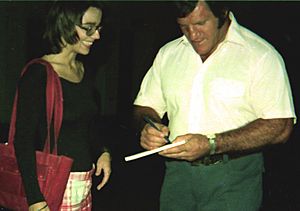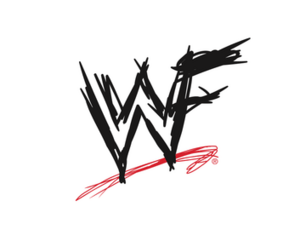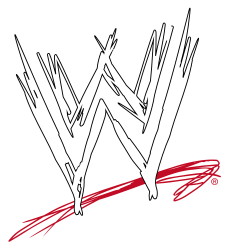History of WWE facts for kids
Quick facts for kids WWE |
|
|---|---|
 |
|
| Details | |
| Established | January 7, 1953 |
| Style | Professional wrestling Sports entertainment |
| Location | Stamford, Connecticut |
| Founder(s) | Jess McMahon or Vincent J. McMahon |
| Parent | Capitol Wrestling Corporation Ltd. (1953–1982) Titan Sports, Inc. (1982–1999) World Wrestling Federation Entertainment, Inc. (1999–2002) World Wrestling Entertainment, Inc. (2002–present) |
| Formerly | Capitol Wrestling Corporation World Wide Wrestling Federation World Wrestling Federation World Wrestling Entertainment |
The history of WWE is a long and exciting journey! It all started in the early 1950s. The company was first known as the Capitol Wrestling Corporation (CWC) in 1953. Over the years, its name changed a few times. It became the World Wide Wrestling Federation (WWWF) in 1963. Then, in 1979, it was called the World Wrestling Federation (WWF). Finally, in 2002, it became World Wrestling Entertainment (WWE). Since 2011, it's simply known as WWE.
WWE is the biggest professional wrestling promotion in the world. It has created many famous wrestlers and exciting stories. It has also hosted some of the most memorable matches in sports entertainment. WWE shows like Raw and SmackDown are watched in over 150 countries. They also have at least 12 big events each year, including WrestleMania. Plus, they hold about 320 live shows around the world every year. In 2014, WWE launched its own 24/7 streaming service, the WWE Network. This network lets fans watch almost all of WWE's past shows and matches.
Contents
Early Days of WWE: Capitol Wrestling Corporation
How WWE Began (1953–1963)
WWE's story began on January 7, 1953. This was when the first show under the name Capitol Wrestling Corporation (CWC) took place. There's a bit of a mystery about who exactly founded CWC. Some say it was Vincent J. McMahon. Others believe it was his father, Roderick James “Jess” McMahon, who passed away in 1954.
At that time, wrestling was organized by a group called the NWA. They had a top champion whose title was defended in different wrestling companies. The NWA liked to have strong, believable wrestlers as champions. But these champions didn't always excite fans in the CWC's area. In 1961, the NWA decided to make "Nature Boy" Buddy Rogers their champion. He was a great showman and very popular in the Northeast.
However, CWC's leaders, McMahon and Toots Mondt, wanted Rogers to wrestle mostly in their area. Rogers lost his NWA championship to Lou Thesz in Canada on January 24, 1963. Because of this, Mondt, McMahon, and CWC left the NWA. They decided to start their own wrestling company, which they called the World Wide Wrestling Federation (WWWF).
World Wide Wrestling Federation (WWWF)
The Rise of Bruno Sammartino (1963–1980)
The World Wide Wrestling Federation (WWWF) officially started on January 24, 1963. On April 25, 1963, Buddy Rogers was given the new WWWF World Heavyweight Championship. It was said he won it in a tournament in Brazil. But just a month later, on May 17, 1963, he lost the championship to Bruno Sammartino. Rogers had a heart attack before the match, so it was kept very short.
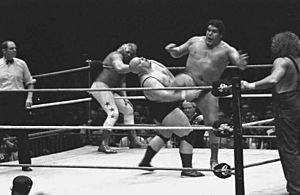
Sammartino held the title for an amazing seven years, eight months, and one day. This is the longest time anyone has held a men's world championship in wrestling history! While Sammartino was the top star, wrestlers like Superstar Billy Graham and Bob Backlund were also very popular.
In the 1970s, WWWF became famous for holding its biggest shows at places like Shea Stadium and Madison Square Garden. They used popular former wrestlers like Captain Lou Albano and "Classy" Freddie Blassie as managers for Sammartino's opponents. These managers helped make the bad guys (called heels) more exciting. At this time, only good guys (called babyfaces or fan favorites) had long championship reigns. Bad guys usually held the title for a short time before losing it to a good guy.
WWWF shows were a bit different from other wrestling companies. Their main event matches often happened in the middle of the show. This was to make fans want to buy tickets for the next event. Popular wrestlers like Chief Jay Strongbow would wrestle at the end to send the crowd home happy. WWWF also featured famous wrestlers from other areas, like Dusty Rhodes. They also had the most popular wrestler in the world at the time, André the Giant.
WWWF held big events called Showdown at Shea three times. These were in 1972, 1976, and 1980. Bruno Sammartino was in the main event of the 1972 and 1980 shows. In 1976, the main event was a special fight between Muhammad Ali and Antonio Inoki.
Toots Mondt left WWWF in the late 1960s. Vincent J. McMahon then took full control of the company in 1971. In March 1979, to help with marketing, the World Wide Wrestling Federation changed its name to the World Wrestling Federation (WWF).
World Wrestling Federation (WWF)
A New Era Begins (1980–1982)
In 1980, Vincent K. McMahon, the son of Vincent J. McMahon, started a new company called Titan Sports, Inc. He also applied for trademarks for the initials "WWF".
The Golden Era of Wrestling (1982–1993)
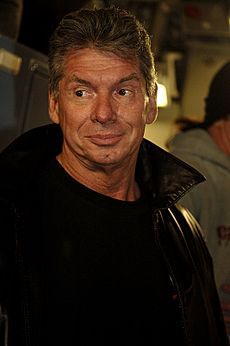
In 1982, Vince McMahon bought the WWF from his father. He wanted to make WWF the best wrestling company in the world. He started to expand, which changed the wrestling business forever. McMahon explained that before, there were many small wrestling companies. He wanted to unite them and make WWF a national company.
McMahon started by getting WWF shows on TV all across the United States. This made other wrestling promoters upset because it broke the old rules of how wrestling companies operated. WWF also used its money from advertising and TV deals to hire wrestlers from other companies.
McMahon's dream of a national wrestling company started to come true when he signed Hulk Hogan. Hogan was already famous outside of wrestling, especially for his role in the movie Rocky III. McMahon also signed Rowdy Roddy Piper to be Hogan's rival. Other important wrestlers joined too, like Jesse "The Body" Ventura, André the Giant, and Jimmy "Superfly" Snuka. In 1984, Hogan became the top star. He won the WWF World Heavyweight Championship on January 23, 1984. He quickly became one of the most famous and loved faces in wrestling.

With more money coming in, McMahon got more TV deals. WWF shows were now seen all over the U.S. McMahon also started selling videos of WWF events outside the Northeast. This made other promoters even angrier. WWF's growing popularity forced other companies to compete directly with them. This extra money allowed McMahon to sign even more talented wrestlers.
To truly make WWF a national company, McMahon needed to tour the whole country. This was very expensive. So, McMahon took a big risk. He planned a huge event called WrestleMania in 1985. WrestleMania was a pay-per-view event, shown on special TV screens. It was promoted as the "Super Bowl of professional wrestling."
WrestleMania was not the first big wrestling event, but McMahon wanted to make wrestling popular with everyone, not just wrestling fans. He wanted to show the entertainment side of the business. For the first WrestleMania, WWF worked with MTV. This led to a lot of WWF coverage on MTV, called the Rock 'n' Wrestling Connection. Famous people like Muhammad Ali, Mr. T, and Cyndi Lauper appeared at the event. This helped WrestleMania become a huge part of popular culture. Using celebrities has been a key part of WWE ever since.
After WrestleMania's success, other wrestling companies started to join forces. One big company, Jim Crockett Promotions (JCP), tried to compete with WWF. But even their big events couldn't match WWF's success. Later, Ted Turner bought JCP, and it became World Championship Wrestling (WCW). WCW was WWF's main competitor until 2001, when WWF bought WCW. WrestleMania became a yearly event, shown in almost 150 countries and in nearly 20 languages.
The peak of the 1980s wrestling boom was WrestleMania III. It set an attendance record with 93,173 fans! In the main event, Hulk Hogan kept his WWF Championship against André the Giant. McMahon used WrestleMania's success to create more yearly pay-per-views. These included SummerSlam, the Royal Rumble, and the Survivor Series. These four shows are still known as the "Big Four" of WWE's events today.
McMahon's focus on entertainment, rather than just sports, made WWF very successful. This idea became known as sports entertainment. During the 1980s, Hulk Hogan became a national hero. He was the face of WWF until he left in 1993. Other stars like "Macho Man" Randy Savage, "Rowdy" Roddy Piper, and The Ultimate Warrior also helped WWF become a financial success. Jim Duggan won the first Royal Rumble match in 1988.
Many wrestlers also became famous for their tag teams. Groups like Demolition and The Hart Foundation made the tag team division strong. Towards the end of this "Golden Age," Bret Hart started to become a big singles star. He won the WWF World Heavyweight Championship in 1992.
The New Generation Era (1993–1997)

Starting in 1992, Vince McMahon began to feature younger wrestlers. By mid-1993, stars like Bret "Hit Man" Hart, Shawn Michaels, The Undertaker, and Diesel became the main attractions of what WWF called the "New Generation." Hulk Hogan left the company in the summer of 1993. Bret Hart became one of the most popular stars during this time.
Competition between wrestling companies grew. In January 1993, WWF launched its prime time TV show, Monday Night Raw, on the USA Network. In 1994, WCW signed Hulk Hogan and other former WWF stars. In 1995, WCW launched Monday Nitro to compete directly with Raw. This started the "Monday Night Wars." At WrestleMania X in 1994, a ladder match between Shawn Michaels and Razor Ramon was highly praised. It was seen as a groundbreaking match that changed ladder matches forever.
By mid-1996, WCW's Nitro started to dominate the TV ratings. This was thanks to the New World Order (nWo), a group led by former WWF wrestlers Hulk Hogan, Scott Hall, and Kevin Nash. More wrestlers left WWF for WCW. But Bret Hart decided to stay with WWF despite a big offer from WCW. At Badd Blood: In Your House in 1997, the first Hell in a Cell match took place. It was between The Undertaker and Shawn Michaels. This match has since become one of the most popular special matches in wrestling history.
The Attitude Era (1997–2002)
In 1997, Vince McMahon decided to change WWF's direction. He made characters more realistic and storylines more exciting and edgy. Rising stars included the D-Generation X group and Stone Cold Steve Austin. Austin's popularity grew after his 1996 King of the Ring win and his famous "Austin 3:16" speech. Even though he started as a bad guy, Austin became incredibly popular.
At Survivor Series on November 9, 1997, WWF showed off its new "scratch" logo. This logo became the company's symbol throughout the Attitude Era. On December 15, 1997, Vince McMahon announced that WWF would be more "innovative and contemporary." He also said that parents should be careful about younger viewers. This marked the official start of the Attitude Era on TV.
After Bret Hart left, the company focused on the popular anti-hero, Stone Cold Steve Austin. His popularity was similar to Hulk Hogan's in the 1980s. At WrestleMania XIV in March 1998, Austin became WWF Champion. This started the "Austin era" and a big rivalry with the evil Mr. McMahon character. This feud was very important in helping WWF win the ratings war against WCW. Later, new talents like The Rock, Triple H, and Mick Foley emerged. They made WWF's singles division stronger. Groups like D-Generation X also helped WWF compete.
WWF's ratings and popularity bounced back. Raw Is War finally beat Nitro in ratings on April 13, 1998, after 84 weeks. Ratings continued to rise through 1998 and 1999. A match between Stone Cold Steve Austin and the Undertaker on June 28, 1999, got a very high rating. It's still the highest-rated part of Raw history.
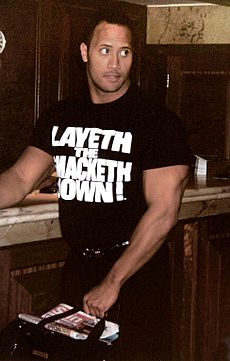
The Attitude Era also saw WWF expand its TV coverage and business. In the summer of 1999, WWF's parent company, Titan Sports, changed its name to World Wrestling Federation Entertainment, Inc. (WWFE). On October 19, 1999, it became a publicly traded company. This meant people could buy shares of the company.
In 1999, WWF launched a second show called SmackDown! on the UPN network. This show competed with WCW's Thunder. SmackDown! started airing weekly on August 26, 1999. In 2000, WWF worked with NBC to create the XFL, a new professional football league. However, the XFL was not successful and only lasted one year.
New writers helped create exciting storylines. These included the Triple H/Cactus Jack feud and the popular rivalry between The Hardy Boyz, Edge and Christian, and The Dudley Boyz. At Survivor Series, Stone Cold Steve Austin was written off TV due to a serious neck injury. At SummerSlam in 2000, WWF introduced the popular Tables, Ladders, and Chairs match.
Before WrestleMania 2000, the McMahon family had a rivalry on TV. This led to a big main event match at WrestleMania. Triple H won the match, becoming the first bad guy to win the main event of WrestleMania. Stone Cold Steve Austin returned in 2000 and won the Royal Rumble in 2001. He then defeated The Rock for the WWF Championship at WrestleMania X-Seven. At this point, WWF had won the "Monday Night Wars" against WCW.
The Invasion Storyline (2001–2002)
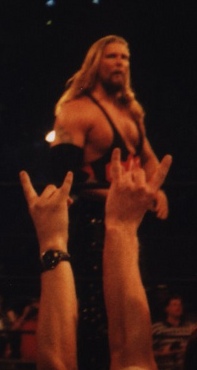
In the "Invasion" storyline, Shane McMahon (in the storyline) bought World Championship Wrestling (WCW) in April 2001. WCW wrestlers then "invaded" WWF. This was the first time since the Monday Night Wars that a major wrestling company could have a feud with another. However, many fans were disappointed with the Invasion. This was because many of WCW's biggest stars were still under contract with WCW's old owner, AOL Time Warner. They chose to stay home and get paid rather than work for WWF for less money.
On July 9, 2001, the stars of WCW and Extreme Championship Wrestling (ECW) joined forces. They formed "The Alliance." Shane McMahon and Stephanie McMahon led this group, with support from original ECW owner Paul Heyman. At Invasion, Stone Cold Steve Austin turned on WWF and helped The Alliance win. At Survivor Series, WWF finally defeated WCW and ECW in a "Winner Takes All Match." This ended the Invasion storyline.
After the Invasion, WWF made some big changes. Ric Flair returned as a "co-owner" of the company. Many former Alliance stars joined the regular WWF roster. At Vengeance 2001, Chris Jericho became the first Undisputed Champion. He beat both The Rock and Stone Cold Steve Austin on the same night.
Eventually, Vince McMahon brought back Hulk Hogan, Kevin Nash, and Scott Hall to reunite the nWo in February 2002. However, Hogan was too popular with fans who remembered his "Hulkamania" days. He soon became a good guy again at WrestleMania X8 after his classic match with The Rock. On March 25, 2002, the World Wrestling Federation had its first-ever WWF draft lottery. This separated the WWF superstars into two brands: Raw and SmackDown!. This started a new era, ending the Attitude Era.
World Wrestling Entertainment / WWE
In 2002, the World Wrestling Federation lost a lawsuit to the World Wildlife Fund over the "WWF" trademark. Because of this, the World Wrestling Federation had to change its name. On May 6, 2002, the company became World Wrestling Entertainment Inc. (WWE). They also removed anything that used the word "Federation." This included toys, video games, and old videos. The old logo was replaced with a new "scratch" logo. The last event under the WWF name was Insurrextion on May 4, 2002. Around this time, the company also started WWE Studios, which makes movies.
The Ruthless Aggression Era (2002–2008)
By April 2002, WWE had many talented wrestlers because they had bought WCW and ECW. To give everyone a chance to shine, WWE started a "Brand Extension." The wrestlers were split into two groups, assigned to either Raw or SmackDown! in a special draft. Wrestlers, commentators, and referees became exclusive to one show. Each show also got its own General Manager. This brand split began on April 1, 2002. On June 24, 2002, Vince McMahon officially called this new period "Ruthless Aggression."
Later in 2002, after WWE Champion Brock Lesnar became exclusive to SmackDown!, a new World Heavyweight Championship was created for Raw. All championships then became exclusive to one show. Also, Raw and SmackDown! started having their own pay-per-view events. Only the four biggest events—Royal Rumble, WrestleMania, SummerSlam, and Survivor Series—featured wrestlers from both brands. This practice of single-brand events ended after WrestleMania 23. Essentially, Raw and SmackDown operated like two separate companies. Each year, a draft would decide which wrestlers went to which brand. This continued until August 2011, when the rosters were combined again.
The Ruthless Aggression era still had some elements from the Attitude Era. However, it had less controversial content and focused more on the wrestling itself.
The two biggest stars of the Attitude Era, Stone Cold Steve Austin and The Rock, left the company in 2003 and 2004. New stars like Brock Lesnar, who became the youngest WWE Champion, and Randy Orton, who became the youngest World Heavyweight Champion, found huge success. Triple H also became very prominent, winning many of his fourteen world championships. The Undertaker's WrestleMania winning streak also started to become famous. Other wrestlers like John Cena, Batista, and Edge also became main event stars and won multiple world championships. From 2002 to 2003, WWE brought in several famous WCW stars, including Goldberg and Ric Flair.
In August 2002, Shawn Michaels returned as a wrestler after being away for over four years. He was very successful and won a World Championship at Survivor Series. The match between Shawn Michaels and Kurt Angle at WrestleMania 21 is considered one of the greatest matches in WWE history. In 2006, Michaels reunited with Triple H to form the popular group D-Generation X again.
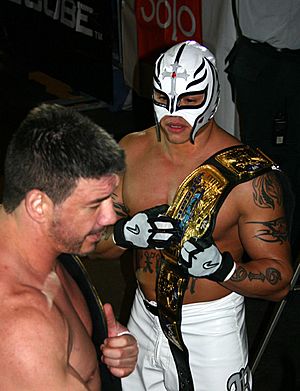
Eddie Guerrero, from the famous Mexican Guerrero wrestling family, became a huge star during this time. He became very popular on SmackDown! in 2003. This led to him becoming a main event wrestler. He won his first world championship, the WWE Championship, at No Way Out in 2004. He defeated Brock Lesnar in a highly praised match. He remained a top wrestler until his sad death on November 13, 2005. He was put into the WWE Hall of Fame the next year. His friend Rey Mysterio then became a major star. Mysterio won the 2006 Royal Rumble match and the World Heavyweight Championship at WrestleMania 22.
John Cena was one of the biggest new stars of the Ruthless Aggression era. When he first started, Cena was popular for his "Doctor of Thuganomics" rapper character. He quickly became a top contender. At WrestleMania 21, he won his first world championship. Cena's popularity exploded when he moved to Raw. He quickly became the face of WWE, a rise not seen since Austin and Hulk Hogan. Cena has granted over 500 wishes for the Make-A-Wish Foundation, which is a record.
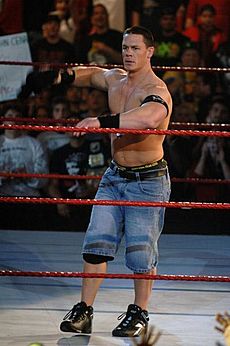
Triple H, Randy Orton, Ric Flair, and Batista were part of the villainous group Evolution. They were very prominent between 2003 and 2005.
Starting in early 2005, Batista also became very popular, much like Cena. He won the 2005 Royal Rumble and the World Heavyweight Championship at WrestleMania 21. Later in 2005, Batista defeated Triple H in a highly praised Hell in a Cell match.
Randy Orton became a prominent Superstar during this time. He became the youngest world champion in WWE history at age 24. He defeated Chris Benoit at SummerSlam in 2004. Called "the Legend Killer," he had rivalries with famous wrestlers like The Undertaker and Hulk Hogan. He also formed the villainous tag team Rated-RKO with Edge. After returning to singles competition, Orton won the WWE Championship multiple times. In 2007, Orton began a famous rivalry with John Cena.
Rising star CM Punk made his WWE debut in 2006. In 2008, he won the Money in the Bank briefcase. He used it to win the World Heavyweight Championship from Edge.
The last pay-per-view event with an adult rating was The Great American Bash in 2008. After this event, WWE changed its programming to be TV-PG, which means it's more family-friendly.
Money in the Bank (2005)
The idea for the Money in the Bank match was introduced in March 2005 by Chris Jericho. He suggested it to the Raw general manager, Eric Bischoff. Bischoff liked the idea and set it for WrestleMania 21. Six wrestlers participated, and Edge won the first match. Since then, this match has often helped new stars become main event wrestlers. Winners include CM Punk, The Miz, and Daniel Bryan. The match was originally only at WrestleMania. But in 2010, the Money in the Bank pay-per-view event was created. In 2017, Shane McMahon announced the first-ever women's Money in the Bank match, which was won by Carmella.
The Return of ECW (2006–2010)
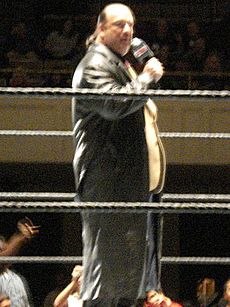
By 2004, WWE started bringing back Extreme Championship Wrestling (ECW). They did this by showing old ECW videos and releasing books about it.
On May 26, 2006, WWE officially announced that ECW would return with its own show. It would air on the Sci Fi Channel (now Syfy) starting June 13, 2006. On June 13, Paul Heyman, the former ECW owner, became the new leader for the ECW brand. He brought back the ECW World Heavyweight Championship. Under WWE, ECW was updated and followed the same rules as other WWE shows. Matches with the old ECW rules were called "Extreme Rules" matches. The ECW brand continued until February 16, 2010, when it ended.
The PG Era (2008–2014)
In the summer of 2008, WWE started to move away from its edgier content. They adopted a more family-friendly approach. On July 22, 2008, all WWE shows became TV-PG rated. The SummerSlam event in 2008 was the first pay-per-view under the new PG ratings. While SmackDown had always been TV-PG, Raw shows, which were TV-14, also became TV-PG. Fans started calling this the "PG Era." For example, John Cena's famous finishing move, the F-U, was renamed Attitude Adjustment. Wrestlers were also no longer allowed to intentionally bleed during matches.
John Cena remained the top star of the company during this era. New superstars like Sheamus and Alberto del Rio also became very successful. In 2009, D-Generation X reunited and won the unified WWE tag team titles. A rivalry between CM Punk and Jeff Hardy in 2009 was highly praised. After Punk forced Hardy to leave WWE (in the storyline), Punk formed a villainous group called the Straight Edge Society.
At WrestleMania XXVI in 2010, veteran wrestler Shawn Michaels retired after losing to The Undertaker. In August 2011, WWE started to end the brand split. Raw became a "SuperShow," meaning wrestlers could appear on both Raw and SmackDown. The year 2011 saw a very popular rivalry between John Cena and CM Punk. Their match at Money in the Bank on July 17, 2011, is considered one of the greatest matches in WWE history. CM Punk held the WWE Championship for 434 days, which is one of the longest reigns ever. He lost it to The Rock in 2013. The Rock then lost the championship to John Cena at WrestleMania 29. The popular group The Shield was also very prominent during this time. On December 15, 2013, the World Heavyweight Championship and WWE Championship were combined. Randy Orton won this unified championship.
The Launch of NXT (2010)
On February 23, 2010, WWE launched a new show on Syfy called NXT. The show was like a reality TV series. It featured eight new wrestlers (Rookies) who were mentored by main roster Superstars (Pros). The first season lasted about three months. The winner was Wade Barrett. Eventually, NXT changed. It became both a TV show and WWE's official training ground for new wrestlers. It is now permanently located at Full Sail University.
The Reality Era (2014–2016)
In 2013, Daniel Bryan became one of the most popular wrestlers in WWE. Fans loved his "Yes!" chant. After the 2014 Royal Rumble, CM Punk left WWE. Meanwhile, fans were upset about how Daniel Bryan was being used. This led to an unplanned change for the WrestleMania XXX main event. On March 24, 2014, Triple H called this time in WWE "The Reality Era." Daniel Bryan was added to the WrestleMania main event. He defeated Randy Orton and Batista in a highly praised match and won the WWE World Heavyweight Championship.
Also at WrestleMania XXX, The Undertaker was defeated for the first time at the event by Brock Lesnar. This ended his amazing 21-match winning streak at WrestleMania. Lesnar then defeated John Cena at SummerSlam to win the WWE World Heavyweight Championship. This was seen as the end of Cena's long run as the top star of WWE. Lesnar became the most dominant wrestler of this era. The launch of the WWE Network and the WWE Performance Center were also big developments. In 2015, Triple H and Stone Cold Steve Austin said that fans now know more about what happens behind the scenes in WWE. They also said that fans have more influence on the company than ever before.
The Triple Threat match at the 2015 Royal Rumble between Seth Rollins, John Cena, and Brock Lesnar was highly praised. It was called one of the best matches of the year. The WWE United States Championship Open Challenge match between John Cena and Antonio Cesaro on July 6, 2015, was also widely praised.
WCW legend Sting made his WWE debut at the 2014 Survivor Series. He had his first-ever WWE match at WrestleMania 31 against Triple H. Also at WrestleMania 31, Seth Rollins became the first person to use his Money in the Bank contract at WrestleMania. He did this during the main event and successfully won the WWE Championship. This event is famously called "the heist of the century" in WWE.
WrestleMania 32 in Arlington, Texas had the largest crowd ever for a WWE event, with over 100,000 attendees. In the main event, Roman Reigns defeated Triple H to win the WWE World Heavyweight Championship.
The New Era (2016–Present)
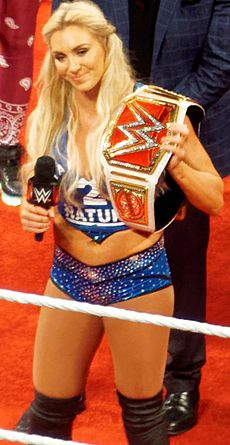
The Payback event on May 1, 2016, was called the start of a "New Era." Roman Reigns continued to be a top star. Later in May 2016, WWE announced that a roster split would happen again, similar to 2002. This began in July. The three former members of The Shield—Dean Ambrose, Roman Reigns, and Seth Rollins—have been heavily featured. All three exchanged the WWE World Heavyweight Championship at Money in the Bank in June 2016.
The WWE World Championship moved to the SmackDown brand. A new WWE Universal Championship was created for the Raw brand. Finn Bálor became the first Universal Champion.
The Divas division was renamed the Women's division. The company introduced a new WWE Women's Championship and retired the old Divas Championship. Female Superstars started getting more time for their matches. They also began to get as much attention as male superstars. This is why the "New Era" is also known as the start of the "women's evolution." At the Hell in a Cell event in 2016, Charlotte Flair and Sasha Banks made history. They were the first women to main event a WWE pay-per-view. They also had the first-ever women's Hell in a Cell match. Women started participating in matches that used to be only for men. These included the Money in the Bank, Royal Rumble, and Elimination Chamber matches.
On October 28, 2018, WWE held its first all-women pay-per-view, WWE Evolution. It featured a highly praised "Last Woman Standing" match between Becky Lynch and Charlotte Flair, which Lynch won. Becky Lynch became very popular. This led to WrestleMania 35, where three women—Becky Lynch, Charlotte Flair, and Ronda Rousey—main-evented the show. Becky Lynch won, making it the first time women main-evented WrestleMania.
At WrestleMania 35, Kofi Kingston became the first African-born WWE Champion. He defeated Daniel Bryan at the event.
WWE also established Braun Strowman as a big superstar in 2017. Top wrestler John Cena became a part-time performer around this time. He lost to Roman Reigns in a match that was seen as "passing the torch." The New Day also became record eight-time tag team champions.
WrestleMania 36 was the first WrestleMania to be filmed without an audience. This was due to the COVID-19 pandemic. It was shown on two nights in April 2020. The Undertaker's match was confirmed to be his last. Despite no audience, WrestleMania 36 was the most-viewed event in WWE history.
On July 2, 2020, WWE bought the wrestling company Evolve. This gave them all of Evolve's wrestlers and rights.
Bobby Lashley returned to WWE in 2018 after a decade away. In 2021, he won the WWE Championship. Bianca Belair became a dominant star in the women's division in 2021. She won the 2021 Women's Royal Rumble match. She then defeated Sasha Banks in the main event of Night 1 of WrestleMania 37 to win the SmackDown Women's Championship.
At Night 1 of WrestleMania 38 in April 2022, veteran Stone Cold Steve Austin wrestled for the first time in 19 years. He defeated Kevin Owens. The next night, in the main event of Night 2, Roman Reigns defeated Brock Lesnar. He won both the WWE Championship and WWE Universal Championship. He became the first wrestler to hold both titles at the same time.
WWE Network Moves to Peacock (2021)
In 2021, WWE announced that NBCUniversal Television and Streaming bought the exclusive U.S. rights to the WWE Network. The service moved to Peacock on March 18, 2021. All WWE Network content started to be on Peacock. This content was part of Peacock's paid subscription. Some free content was also available. WWE promised to make a "signature documentary" for Peacock every year. The standalone WWE Network stopped operating in the United States on April 4, 2021.
Not all content was available right away. Peacock had to review the library to meet its standards. Because of Peacock's strict rules, the company received criticism. Some iconic moments from the Attitude Era were removed. These moments were considered inappropriate by Peacock. This meant they were no longer available on any official WWE platform. Peacock also gained more control over WWE's newer content. This made it more family-friendly. Despite the criticism, WWE executive Triple H defended the move to Peacock in April 2021.
Changes in Leadership (2022)
On June 17, 2022, Vince McMahon stepped down as chairman and CEO of WWE. This happened during an investigation into payments he made to a former employee. His daughter, Stephanie McMahon, became the interim chairwoman and CEO. Despite this, Vince McMahon appeared on WWE SmackDown that night. He gave a short speech, saying "then, now, forever and most importantly together." News media saw this as Vince letting people know he was still in charge of creative decisions.
On July 22, 2022, Vince McMahon officially announced his retirement on Twitter. He said, "At 77, time for me to retire. Thank you, WWE Universe. Then. Now. Forever. Together." After his retirement, Stephanie McMahon was officially named chairwoman. She and Nick Khan were named Co-CEOs of WWE. Triple H returned to his role as Executive Vice President of Talent Relations. He also started leading WWE's creative team.
WWE Online
In 1998, Shane McMahon helped create WWE's digital media department. He launched WWF.com on May 21, 1998. This website is now known as WWE.com. It gets more than seven million visits each month.
|



